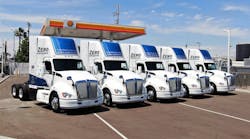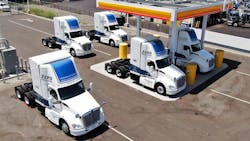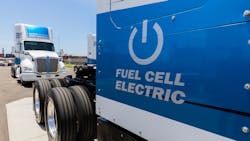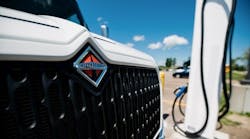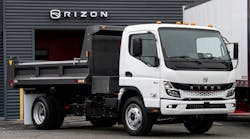The Port of Los Angeles is launching five hydrogen-powered fuel cell electric vehicles (FCEV) as well as the grand opening of two hydrogen fueling stations under the $82.5 million Shore-to-Store (S2S) project. The 12-month demonstration of zero-emissions Class 8 trucks will now include five more hydrogen-fueled heavy-duty trucks, two battery-electric yard tractors, and two battery-electric forklifts.
This demonstration has been designed to advance the Port’s Clean Air Action Plan goals and help California achieve statewide climate change, air quality improvement and sustainability targets for reducing greenhouse gases and toxic air emissions. In addition, it will assess the operational and technical feasibility of the vehicles in a heavy-duty setting, as well as to expand infrastructure to support hydrogen throughout the region.
“Transporting goods between our Port and the Inland Empire is the first leg of this next journey toward a zero-emissions future,” Gene Seroka, Port of Los Angeles executive director, said. “This project is a model for developing and commercializing the next generation of clean trucks and cargo-handling equipment for the region and beyond. Just as the air we breathe extends beyond the Port’s footprint, so should the clean air and economic benefits we believe this project will yield.”
The California Air Resources Board (CARB) is supporting the project with a matching grant of $41.1 million. Project partners are contributing the remaining $41.4 million in financial and in-kind support.
"For generations, neighborhoods located next to high volume traffic corridors have experienced disproportionately high rates of air pollution and pollution-related illness, particularly in the greater Los Angeles region," Craig Segall, CARB deputy executive officer, said. "We are working steadily to change this trajectory by helping to fund, support and promote comprehensive efforts like the Port of L.A.'s Shore-to-Store Project that will run cleaner and quieter trucks that will substantially reduce greenhouse gas emissions and lower smog-forming emissions as well. It's a sizable investment in a project with the potential to radically transform how we move freight in one of the most populous regions in the U.S."
Partners operating the trucks are Toyota Logistics Services (TLS), UPS, and trucking companies Total Transportation Services (TTSI) and Southern Counties Express (SCE).
“Getting these trucks into service is another positive step for this groundbreaking program,” Gordon Reimer, president of Southern Counties Express, said. “We have been involved with this project since the beginning, so we are excited to see the continued progress of this technology.”
Gas and technology leader Air Liquide is also participating as a fuel supplier. The Port of Hueneme will partner on drayage runs and serve as the site for testing the zero-emissions yard tractors.
The Port’s technology development partners are Toyota Motor North America, which designed and built the powertrain’s fuel cell electric power supply system; Kenworth Truck Co., which designed and built the Class 8 trucks with Toyota’s fuel cell electric system; and Shell Oil Products U.S. (Shell), who designed, built and will operate the project’s two new high-capacity hydrogen fueling stations in Wilmington and Ontario.
“Shell believes hydrogen offers a promising solution to achieving net-zero emissions both in terms of immediate improvements of local air quality as well as meeting long-term climate goals especially for heavy-duty vehicles and for long-distance travel,” Paul Bogers, vice president of hydrogen at Shell. “That’s why we are working with truck manufacturers, fleets, governments, and others to coordinate hydrogen infrastructure investments in high-traffic freight areas like the Port of Los Angeles, Port of Long Beach, the Los Angeles basin and the Inland Empire.
“Our hydrogen refueling stations in Ontario and Wilmington play a growing role in reducing truck emissions in these highly populated areas,” Bogers added. “We are grateful to our consortium partners, the California Energy Commission and the California Air Resources Board for their visionary support of the hydrogen economy.”
